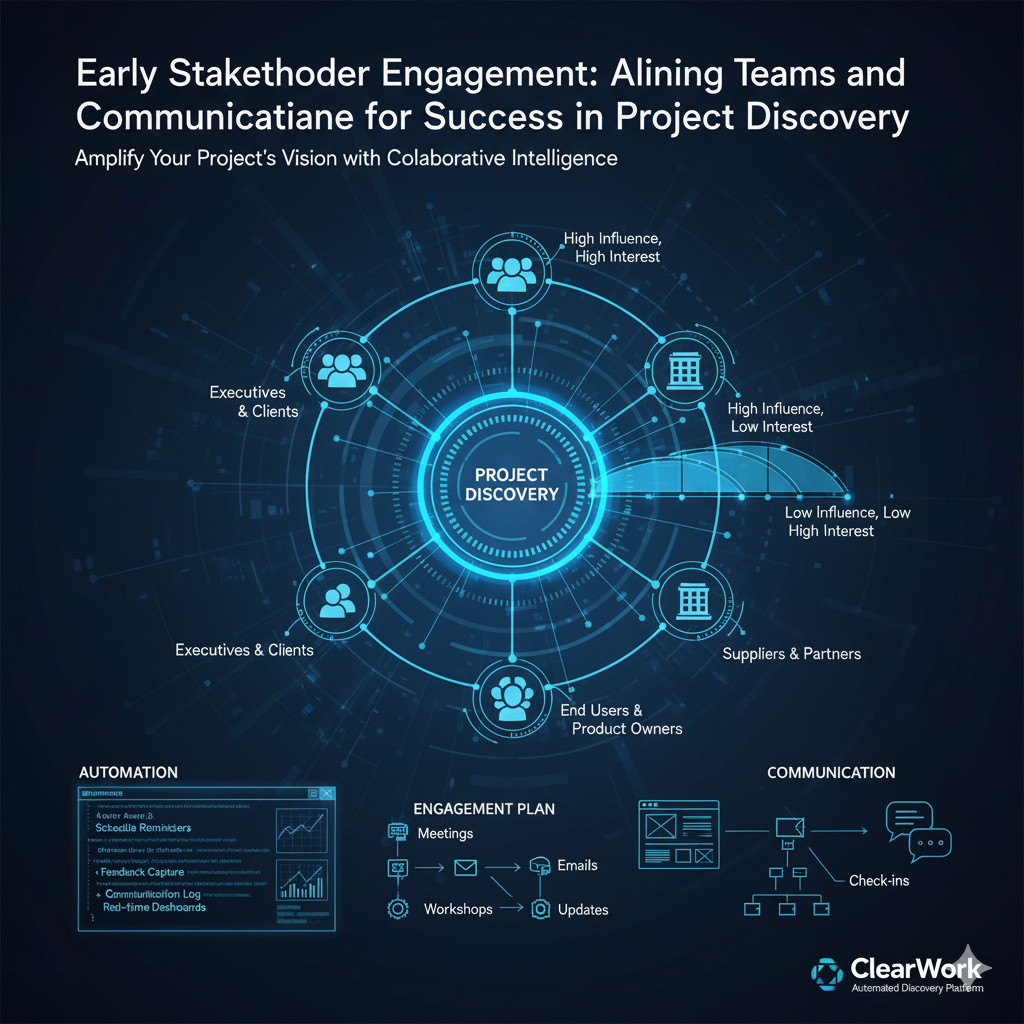Early Stakeholder Engagement: Aligning Teams and Communicating for Success in Project Discovery
Engaging the right people early can make or break a project. In the discovery phase, teams gather information, define scope and set the foundation for development. Bringing stakeholders into this process ensures that expectations are aligned and prevents costly miscommunications down the road. In this article, we explore how to identify stakeholders, build a plan for engaging them and communicate effectively throughout discovery.
Why Engage Stakeholders Early?
When stakeholders are involved from the start, they share their goals, concerns and constraints before decisions are made. This early involvement:
- Aligns everyone around a shared vision and reduces conflicting priorities.
- Surfaces hidden requirements or risks that might otherwise emerge later.
- Builds trust and buy‑in, making it easier to secure approvals and support throughout the project.
By investing time up front to involve stakeholders, teams avoid costly rework and keep projects on track.
Identifying and Categorizing Stakeholders
A stakeholder is anyone who has an interest in or influence on your project. Stakeholders can include executives, project managers, end users, clients, suppliers or investors. To manage relationships effectively, start by:
- Listing all stakeholders: Write down everyone who might be affected by or have input into the project.
- Assessing influence and interest: Determine how much power each person has over key decisions and how much they care about the outcome.
- Grouping stakeholders: Divide them into categories such as high interest/high influence, high interest/low influence, high influence/low interest and low interest/low influence.
- Defining roles: For each stakeholder, note their responsibilities, decision authority and preferred communication style.
This mapping helps tailor your engagement efforts and ensures you reach the right people at the right time.
Building a Stakeholder Engagement Plan
A stakeholder engagement plan lays out how you will communicate with stakeholders and involves:
- Stakeholder details: Name, role and contact information.
- Engagement level: How interested and influential they are.
- Communication frequency: How often you will provide updates or meet.
- Communication channel: The preferred method of communication—such as meetings, email, dashboard updates or reports.
- Information type: The kind of information you’ll share (e.g., status updates, decisions needed, risks).
This plan should be flexible. Projects evolve, so revisit and adjust the plan as new stakeholders emerge or engagement levels change.
Engaging Stakeholders During Discovery
Once the plan is in place, it’s time to put it into action. Effective engagement includes:
- Kickoff meetings: Align on scope, goals and expectations.
- One‑on‑one interviews: Capture individual concerns and insights.
- Workshops and brainstorming sessions: Foster collaboration and generate ideas.
- Regular check‑ins: Schedule recurring updates to keep everyone informed and address new questions.
- Visual communication: Use wireframes, diagrams or prototypes to help stakeholders understand complex concepts.
Throughout discovery, document feedback, update requirements and ensure all voices are heard. Clear and consistent communication builds confidence and prevents misunderstandings.
Overcoming Common Challenges
Stakeholder engagement isn’t without pitfalls. Teams often face:
- Misaligned expectations: Prevent this by setting clear objectives, deliverables and milestones early on.
- Scope creep: Define the discovery scope and stick to it; adjust only after assessing the impact on timeline and budget.
- Limited availability: Schedule meetings in advance and use asynchronous methods—such as recorded briefings or shared documents—for stakeholders who can’t attend.
- Communication overload: Avoid bombarding stakeholders with every detail. Tailor information to their level of interest and influence.
- Unclear ownership: Create a responsibility matrix to clarify who owns which decisions and tasks.
By anticipating these challenges, teams can manage stakeholder relationships more effectively.
Automating Stakeholder Engagement
Much of stakeholder engagement involves coordination and documentation. Automation tools can:
- Schedule meetings and send reminders.
- Collect feedback through surveys or forms.
- Maintain the stakeholder register and track communication history.
- Share real‑time dashboards with project updates.
Automation reduces administrative tasks and keeps everyone aligned, freeing the team to focus on building relationships and making decisions.
Conclusion
Stakeholder engagement is a critical component of the discovery phase. By identifying stakeholders early, building a structured engagement plan and communicating consistently, you lay the groundwork for a successful project. For a broader look at how discovery fits into the project lifecycle—and how to integrate stakeholder engagement with requirements gathering and planning—read our Ultimate Guide to the Project Discovery Phase. Early alignment and clear communication not only reduce risks but also accelerate progress toward your project goals.
Frequently Asked Questions
1. Who qualifies as a stakeholder in the discovery phase?
- Anyone with an interest in or influence on the project, including executives, product owners, end users, developers, clients or suppliers.
- Stakeholders can be internal or external to your organization.
- It’s important to list them all at the start to ensure no critical voice is missed.
2. What’s the difference between high influence and high interest stakeholders?
- High influence refers to the power to make decisions or allocate resources.
- High interest means they care deeply about the project’s outcome but may not have decision authority.
- Understanding both helps you determine how often to communicate and what level of detail to provide.
3. How often should I update stakeholders during discovery?
- The frequency depends on their influence and interest.
- Key decision makers may require weekly updates, while others might need only major milestones.
- Regular check‑ins help maintain alignment and prevent surprises.
4. What if a stakeholder resists participating in discovery?
- Seek to understand the reason for resistance—time constraints, perceived irrelevance or lack of clarity.
- Offer flexible engagement options like asynchronous feedback or short surveys.
- Emphasize the impact of their input on project success to encourage participation.
5. How can automation help with stakeholder engagement?
- Tools can schedule meetings, send reminders and collect feedback automatically.
- They maintain a centralized record of communications and decisions, ensuring transparency.
- By reducing administrative burden, automation allows the team to focus on meaningful interactions and decision making.

